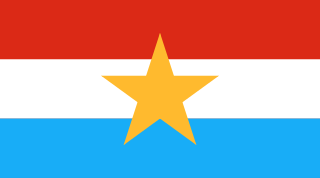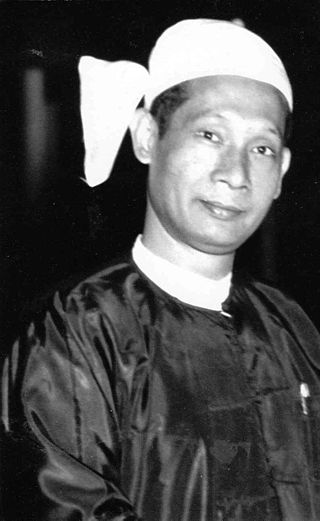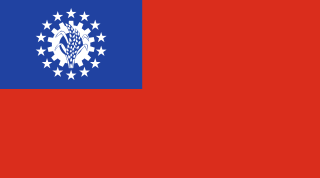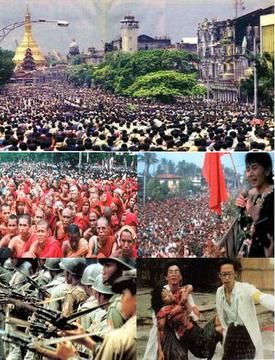
Myanmar operates de jure as a unitary assembly-independent presidential republic under its 2008 constitution. On 1 February 2021, Myanmar's military took over the government in a coup, causing ongoing anti-coup protests.

The Tatmadaw is the military of Myanmar. It is administered by the Ministry of Defence and composed of the Myanmar Army, the Myanmar Navy and the Myanmar Air Force. Auxiliary services include the Myanmar Police Force, the Border Guard Forces, the Myanmar Coast Guard, and the People's Militia Units. Since independence in 1948, the Tatmadaw has faced significant ethnic insurgencies, especially in Chin, Kachin, Kayin, Kayah, and Shan states. General Ne Win took control of the country in a 1962 coup d'état, attempting to build an autarkic society called the Burmese Way to Socialism. Following the violent repression of nationwide protests in 1988, the military agreed to free elections in 1990, but ignored the resulting victory of the National League for Democracy and imprisoned its leader Aung San Suu Kyi. The 1990s also saw the escalation of the conflict involving Buddhists and Rohingya Muslims in Rakhine State due to RSO attacks on the Tatmadaw forces, which saw the Rohingya minority facing oppression and, starting in 2017, genocide, under the rule of democratically elected president Aung San Suu Kyi.

Ne Win was a Burmese politician and military commander who served as Prime Minister of Burma from 1958 to 1960 and 1962 to 1974, and also President of Burma from 1962 to 1981. Ne Win was Burma's military dictator during the Socialist Burma period of 1962 to 1988.
The history of Myanmar covers the period from the time of first-known human settlements 13,000 years ago to the present day. The earliest inhabitants of recorded history were a Tibeto-Burman-speaking people who established the Pyu city-states ranged as far south as Pyay and adopted Theravada Buddhism.

Nu, commonly known as U Nu and also by the honorific name Thakin Nu, was a leading Burmese statesman and nationalist politician. He was the first Prime Minister of Burma under the provisions of the 1947 Constitution of the Union of Burma, from 4 January 1948 to 12 June 1956, again from 28 February 1957 to 28 October 1958, and finally from 4 April 1960 to 2 March 1962.

The Anti-Fascist People's Freedom League (AFPFL) was the dominant political alliance in Burma from 1945 to 1958. It consisted of political parties and mass and class organizations.

Operation Dragon King, officially known as Operation Nagamin in English, was a military operation carried in 1978 out by the Tatmadaw and immigration officials in northern Arakan, Burma, during the socialist rule of Ne Win.

Ba Swe was the second Prime Minister of Burma. He was a leading Burmese politician during the decade after the country gained its independence from Britain in 1948. He held the position of prime minister from 12 June 1956 to 28 February 1957. When Ba Swe became prime minister, Time magazine reported the news in an article titled: 'The Day of the Tiger' based on his nickname 'Big Tiger' since his university days in the 1930s as a student leader.

The Burmese Way to Socialism, also known as the Burmese Road to Socialism, was the state ideology of the Socialist Republic of the Union of Burma, the socialist state governed by the Burma Socialist Programme Party (BSPP) from 1962 to 1988.

Burma (Myanmar) was under the military dictatorship of Ne Win from 1962 to 1988. Ne Win and his allies in the Tatmadaw overthrew the democratically elected government of Prime Minister U Nu in a coup d'état on 2 March 1962. A day later, the coupists established the Revolutionary Council of the Union of Burma as the country's unelected governing body. In April 1962, the Revolutionary Council introduced the Burmese Way to Socialism and declared it Burma's state ideology. The Revolutionary Council then founded the Burma Socialist Programme Party (BSPP) as the country's vanguard party on 4 July 1962. In 1974, Ne Win introduced a new constitution and replaced the Revolutionary Council with a "people's assembly" consisting solely of BSPP members. The country's official name was also changed from the Union of Burma to the Socialist Republic of the Union of Burma.

The 8888 Uprising, also known as the People Power Uprising and the 1988 Uprising, was a series of nationwide protests, marches, and riots in Burma that peaked in August 1988. Key events occurred on 8 August 1988 and therefore it is commonly known as the "8888 Uprising". The protests began as a student movement and were organised largely by university students at the Rangoon Arts and Sciences University and the Rangoon Institute of Technology (RIT).

Brigadier General Aung Gyi was a Burmese military officer and politician. He was a cofounder of the National League for Democracy and served as president of the party.

The first fourteen years of independent Burma (Myanmar) were marred by several communist and ethnic insurgencies. Prominent insurgent groups during this period include the Communist Party of Burma led by Thakin Than Tun, the Communist Party (Burma) led by Thakin Soe, the People's Volunteer Organisation led by Bo La Yaung, the Revolutionary Burma Army (RBA) led by communist officers Bo Zeya, Bo Yan Aung and Bo Yè Htut, and the Karen National Union (KNU).

Insurgencies have been ongoing in Myanmar since 1948, the year the country, then known as Burma, gained independence from the United Kingdom. The conflict has largely been ethnic-based, with several ethnic armed groups fighting Myanmar's armed forces, the Tatmadaw, for self-determination. Despite numerous ceasefires and the creation of autonomous self-administered zones in 2008, many armed groups continue to call for independence, increased autonomy, or the federalisation of the country. The conflict is the world's longest ongoing civil war, having spanned more than seven decades.

The Shan State Army was one of the largest insurgent groups that fought government forces in Shan State, Myanmar (Burma). The SSA was founded in 1964 after the merging of two existing insurgent groups.

The Communist Party of Burma (CPB), also known as the Burma Communist Party (BCP), is a clandestine communist party in Myanmar (Burma). It is the oldest existing political party in the country.
The 1962 Burmese coup d'état marked the beginning of one-party rule in Burma (Myanmar) and the political dominance of the military in Burmese politics. In the 2 March 1962 coup, the military replaced the civilian AFPFL-government headed by Prime Minister U Nu, along with the Union Revolutionary Council Chaired by General Ne Win.

The communist insurgency in Burma was waged primarily by the Communist Party of Burma and the Communist Party (Burma) from 1948 to 1989. The conflict ended when the CPB, severely weakened by an internal mutiny, disbanded its armed wing.

Israel–Myanmar relations refers to the bilateral relations between Israel and Myanmar, established in 1953. Myanmar was one of the first countries in Asia to recognize Israel's independence and establish diplomatic ties with the state. Today, the countries cooperate in the fields of agriculture, health and education. Israel has an embassy in Yangon, and Myanmar has an embassy in Tel Aviv. Myanmar joins Singapore as one of two Southeast Asian States that do not recognize the State of Palestine.

The Caretaker Government of Ne Win was formed in 1958 after Ne Win, then Chief of Staff, took over state power from U Nu, then Prime Minister. This is the first caretaker government in Burmese history. After the 1960 election, power was restored to U Nu.

















